When you think of historical wargaming in the time of Rome, you usually think of vast legions clashing on the fields of battle against barbarian hordes. Gangs of Rome invites you to try something different. Focused on the conflicts within the city of Rome itself between gangs of violent thugs backed by competing politicians, Gangs of Rome is an action-packed skirmish game with a ton of narrative potential.
Gangs of Rome is published by Footsore Miniatures and its second edition released in April 2024 after a successful Kickstarter campaign, with some significant changes from the first edition that make it a lot easier to get into.
Thanks to Footsore for sending over the core rulebook and accessory kit for this review.
What Is Gangs of Rome?
Gangs of Rome is a city-based skirmish game featuring combat between gangs of between six and eight models each. There’s a big emphasis on vertical movement on dense terrain, with mobs of civilians belonging to neither side roaming the streets.
Initiative is determined by placing a token for each gang fighter into a bag, plus a number of extra tokens for the mobs equal to half the number of mobs in the game (usually 3-5) rounded up. Players alternate drawing tokens from the bag and if either player draws a token of one of the gang’s colours they place it next to one of their models and activate it. If they draw one of the mob tokens, they instead get to activate one of the mobs.
Activations use a system called the action stack, in which you declare up to four actions you’d like to take, including moving, climbing, attacking, picking up objectives, and binding wounds. You measure out where those actions would take you and place up to four markers in each of those locations. Then you roll a number of d6s equal to your Agility stat (between 5 and 7), and each result of a 4+ is a successful action that you get to perform. Where the system gets interesting is that each action that you declared but didn’t get enough successes to complete gives you a stress, and each point of stress makes you roll one less dice on your Agility rolls until you successfully complete an action stack.
It’s a really interesting core mechanic with a fun push-your-luck element that makes you plan out your actions carefully and consider just how much you want to risk. While failing on some actions like moving will only accumulate stress, failing to make a successful leap or climb will cause you to fall and take damage.
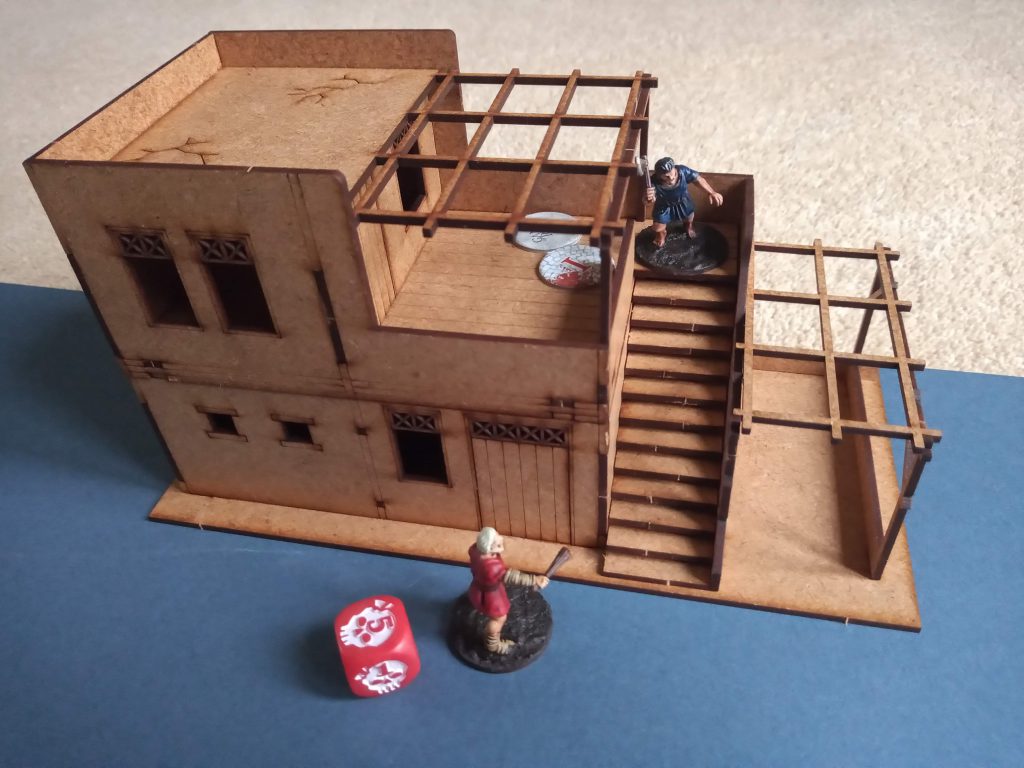
Combat is pretty simple as well. Just roll a number of dice equal to your Attack stat (between 5 and 7), and each roll of 4+ gets you a success. Your opponent rolls a number of dice equal to their Defence stat (3 or 4, very occasionally higher thanks to armour), and each roll of 4+ cancels one of your successes. You deal damage to your opponent’s Vitality stat (again between 5 and 7) equal to your remaining successes. If the defender suffered one point of damage or less, they get to attack back, and if they deal more damage than the attacker, the attacker counts as failing the action. The defender’s ability to attack back applies not just in melee, but at range as well if they have a ranged weapon.
The ability to stack attack actions means you can potentially deal quite a bit of damage in one go, but the ability for your opponent to respond if you roll badly leaves open the potential for some quite significant reversals of fortune. The ability for models to use an action to bind their wounds, regaining between one and three Vitality each time, leads to some more interesting risk-reward gameplay but it also means a one-on-one fight has the potential to drag out all game if both players are cautious and there’s no outside interference.
The other really interesting aspect of the core rules are the mobs. These are 80mm bases with five models on each of them that represent the entrances, exits, and concentrations of members of a larger crowd that’s assumed to take up most of the board. Mobs are probably the most fun part of the system, and essentially act as moving terrain with some interesting quirks. Mobs block conventional movement, and can even block objectives if they end up standing on top of one, but models can use their actions to blend with a mob, allowing them to appear the next turn from any mob on the board, but risking angering the mob if they fail their action.
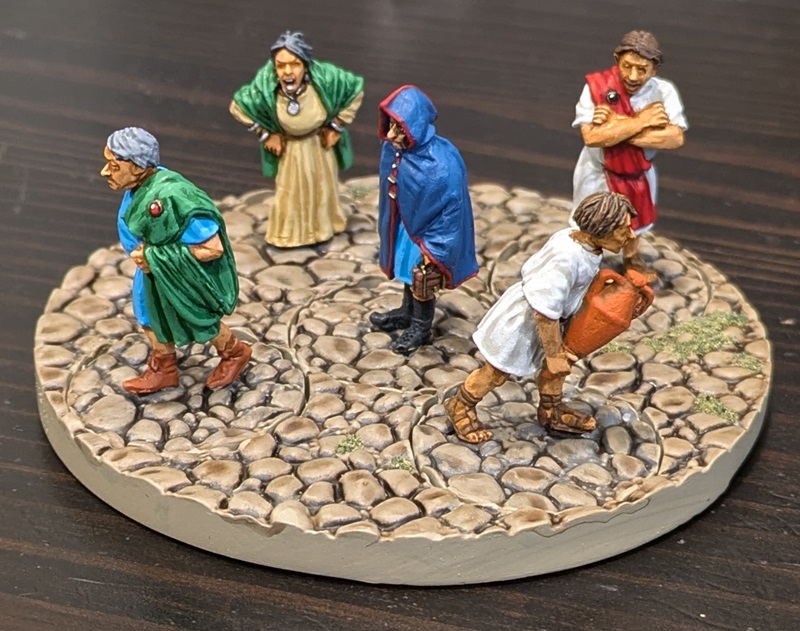
When you draw a mob token, the player who drew it can choose to either move one of the mob bases d6 inches in a direction of their choice, or they can force the mob to make a reaction, which mobs will do on their own if someone makes an attack within 6” of them. On a 1-2 they become scared, moving 6” directly away from the closest gang fighter and potentially trampling anyone who gets in their way. On a 3-4 they do nothing, but on a 5-6 they become angry, moving 6” towards the closest gang fighter and attacking them. Characters can try and manipulate mobs in other ways, such as by attacking them to potentially scare them into running in the opposite direction.
As it’s set in the middle of a city, Gangs of Rome naturally has quite a bit of emphasis on terrain, and in particular vertical movement. While the game still functions with minimal terrain, as there’s no powerful long range weapons to turn the game into a shooting competition, it really benefits from a good board and the book recommends roughly one piece of multi-level, line of sight blocking terrain per square foot (on a 3’x3’ board). That doesn’t necessarily mean you need a board recreating the city of Rome, though Sarissa Precision have some great options if you want to do just that, and games focusing on the countryside with hills, cliffs, and scattered buildings can work just as well.
It’s also worth noting that more and denser terrain won’t always make a better board for this game as you also need wide roads between buildings for mobs to pass through. As a result, if you don’t have any walkways connecting them, buildings can end up feeling oddly isolated and you can often find yourself pretty much ignoring them unless there’s an objective nearby.
Beyond the Basics
All of the above is in the core rules, and you can play a simple enough game using just those and the sample gangs included, but the advanced rules are where you get a lot of the meat of the system, including custom gang creation, eleven different scenarios that can be combined with different times of day and deployment zones for extra replayability, and a bunch of fun optional terrain rules. These include rules for unstable scaffolding that can be shaken to make someone fall off it, and rules for throwing stones, bricks, or amphorae to hurt enemies or distract mobs or vigiles.
The Vigiles Urbani (Rome’s firefighters and night watchmen) are the other major part of the advanced rules, and interact with mobs and gang fighters in some very interesting ways. They’re represented by two figures mounted on a single 40mm round base, with a stat profile on the higher end of that available to gang fighters. During setup, you’ll roll a d6 and add the total number of turns for the scenario (which is five for all the scenarios in the book) to get the Disturbance Timer, which ticks down by one every time a mob reacts.
When the Disturbance Timer hits 0, a Vigile base is placed within base contact of the reacting mob, before moving towards and attacking the closest gang fighter. Then you roll a d6 to get the new Disturbance Timer to see when the next Vigile arrives, which is additionally reduced whenever a Vigile is attacked or killed. Once they’re on the table, the Vigiles will activate any time a mob reacts within their line of sight, moving up to 7” towards the closest gang fighter and attacking them if possible. If you choose to play a scenario set at night, you’ll instead start with two to four Vigiles already on the board and no mobs, with Vigiles activating any time a mob would normally react instead.
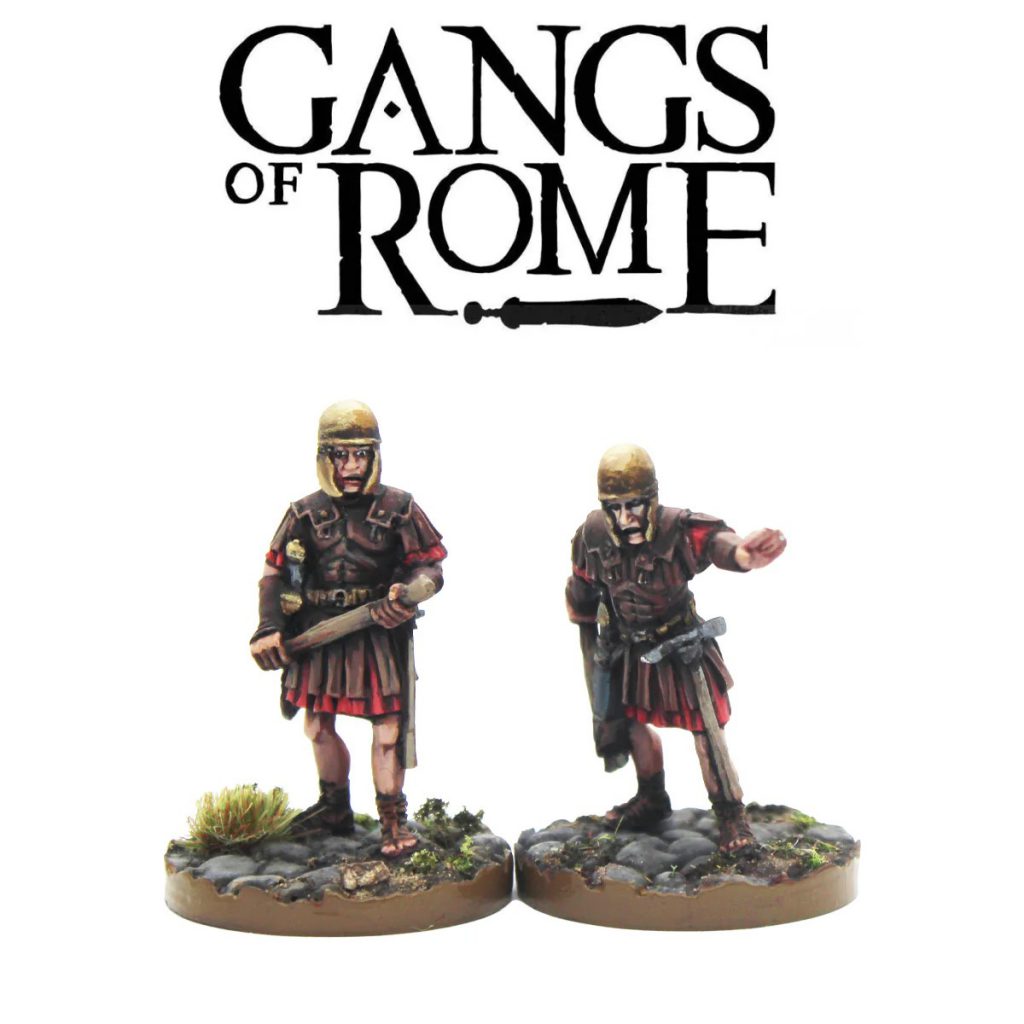
The scenarios included here all look like a lot of fun, though not all of them work well with randomly selected deployment areas, as both the Market Opportunity and Safe House scenarios start with the objectives in the middle while two of the deployment maps allow one player to start in the middle while the other starts on the edge of the map surrounding them. There’s a lot of fun options here, including scenarios where you have to assassinate an enemy noble, steal objectives from market stalls, or search for a hidden stash. One of the most unique scenarios is The Brawl, a simple kill points scenario but with the added tweak that you get bonus points for style, i.e. killing an opponent using two or more sources of damage in a single activation. This scenario really encourages players to do the kind of stuff that this game excels at, combining standard attacks with throwing enemies off buildings or into walls or mobs.
Overall, the rules in this game are very fun and thematic, but the game could definitely use an FAQ as there’s a few different places where it fails to describe some often quite important edge cases. In one particularly egregious example, the combat section tells you what happens if the attacker wins combat or loses combat, but not what happens if there’s a draw. None of this is necessarily game breaking, especially in a casual game like this where you can come to an agreement with your opponent on how to play it, but it’s hard to shake the feeling that this book could have been a lot better with just a little bit more care taken when writing and a little bit more editing.
Creating Your Gang
Gangs of Rome has a fairly unique approach to creating your force, revolving more around creating individual characters than creating a whole gang as a cohesive unit. Characters in your gang are generated almost entirely randomly, one at a time, starting by rolling on some basic tables to get your four core stats. The total of a model’s four stats is its base point cost (between 18 and 25 points), and each model gets a random ability that has a small (1 to 4) point cost associated with it. You also roll randomly for the character’s chosen god, which allows them to perform a special prayer action if they’re your gang’s leader (and is just for flavour on everyone else).
With that done, you get a couple of non-random options. First, you can buy a single piece of equipment for your model for around 1-4 points, with your options ranging from shields and spears to nets and bags of marbles. Characters are assumed to have some sort of melee weapon equipped by default, so you won’t find any options for basic weapons like clubs or axes. You can also spend 10 points on giving your character a certain role, as either a brawler, an acrobat, or a thief. These roles give a couple of special abilities each, mostly revolving around one of the game’s core actions (attack, climb, and blend respectively), with thieves also being able to steal equipment and objectives from other gang fighters.
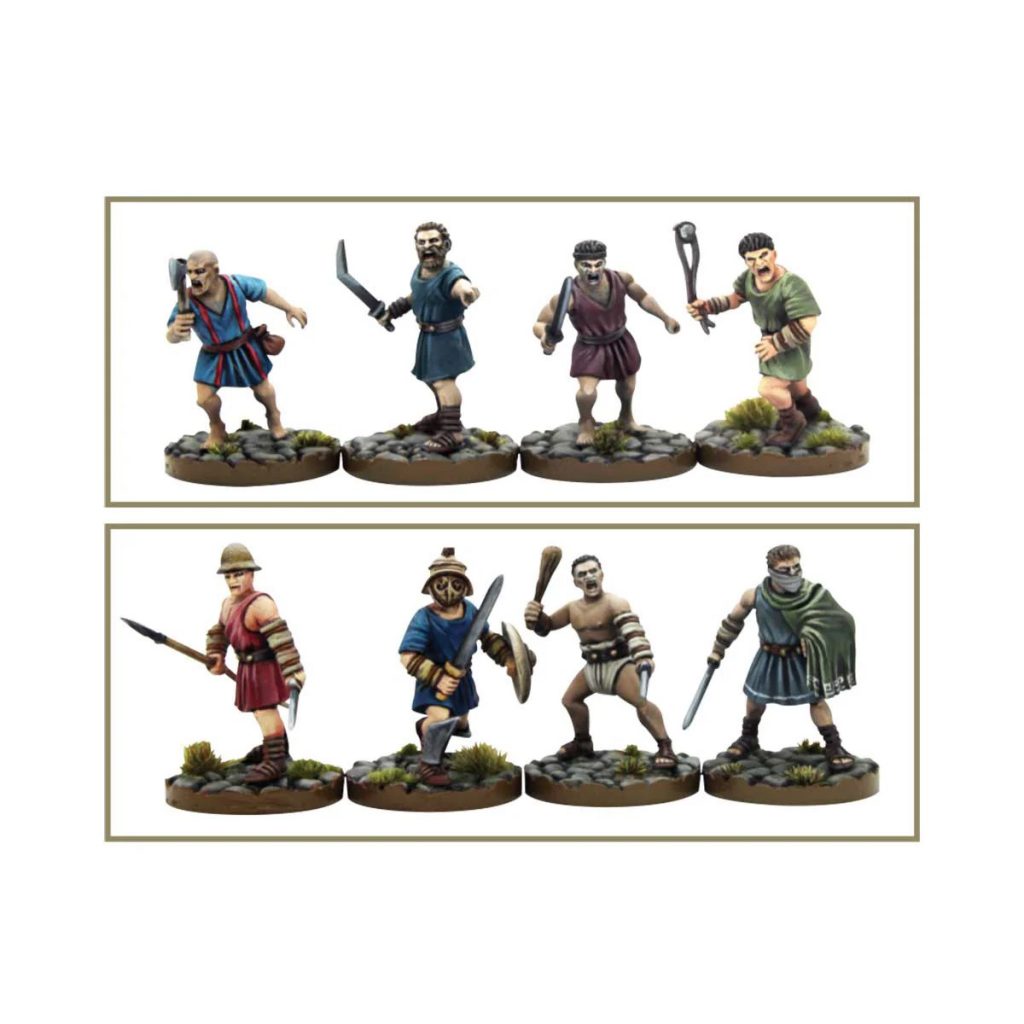
Beyond creating individual characters, the gang creation rules are a bit more freeform. The game actually describes three different methods for creating gangs, with the campaign rules using a variation on these, and players should obviously agree on which method they’ll be using before a game. Games are always played using a maximum points limit (200 by default), but which method you use to create your gang will determine how you select the randomly created gang fighters that you play with.
The first of the listed methods is the simplest, but also the most likely to lead to unfair games. For this method you simply roll up a series of random gang fighters, adding them to your gang one at a time until you hit the points limit. Otherwise you create a pool of gang fighters, either individually or shared between all players, and then draft or select fighters one at a time to fill your list. The latter options definitely seem a bit more fun and fairer, but take a little bit longer to do.
As a whole, the gang creation system ends up mixing randomisation with player choice in some interesting ways, partly to maintain backwards compatibility with the first edition which sold individual models with their own random fighter cards and equipment. That combination has its flaws as well though, and I sometimes wish they had fully committed to either giving players full control over their characters’ stats or letting them play with randomly generated characters without point costs.
Long-term Campaigns
Campaign play can often be the most fun way to play skirmish games, and Gangs of Rome has its own campaign rules if you want to advance your gangs between games. The campaign revolves around each gang’s attempts to get their patron into the Senate, by trying to beat a certain threshold of coin and territory depending on the number of players, while making sure your notoriety is the lowest out of everyone. When one player manages to meet these targets the campaign is over, though there are brief rules for continuing the campaign which give the incumbent senator an extra trait that they can use in the campaign.
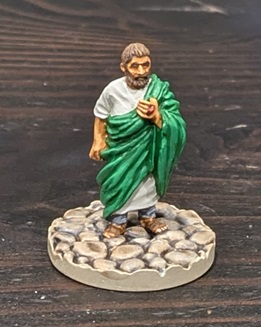
Unlike normal gang creation, during the setup phase you get 300 coins to spend on your initial gang fighters and equipment, but characters don’t start with any abilities initially and equipment is purchased from a more limited selection of basic equipment and placed into your armoury from which it can be assigned to different gang fighters each game. This results in campaign gangs being far less interesting initially than normal gangs, with most of your characters just being collections of random stats for the first few games.
You also start with two residential territories that generate 8 coins each per game, with additional residential, industrial and pleasure territories beginning the game uncontrolled by any player. Each type of territory brings in a certain amount of coin and allows you to take certain actions during the trading phase. They can also be upgraded by spending coins to give them additional abilities and a higher income.
When playing games, players roll off with the winner choosing to either Seize Territory, Sabotage Territory, or Contest Territory, rolling on a different table for each to determine which scenario is played and what the outcome of the battle will be for the victor. Games are played using 200 cost gangs drawn from your roster, with leaders being nominated on a game-by-game basis.
Unfortunately the campaign system is severely hamstrung by how punishing it is to defeated players, which combined with the almost complete lack of catch-up mechanics means that you’ll struggle to keep up after only a couple of big losses. Characters defeated in combat lose any equipment they were carrying, and need to roll on an injury table that has a roughly 1 in 4 chance of the character just dying immediately, and only a roughly 1 in 6 chance of escaping without an injury. This feels extremely punishing, and while starting with 300 coins gives you a bit of a buffer, that won’t last long if you have a run of bad luck.
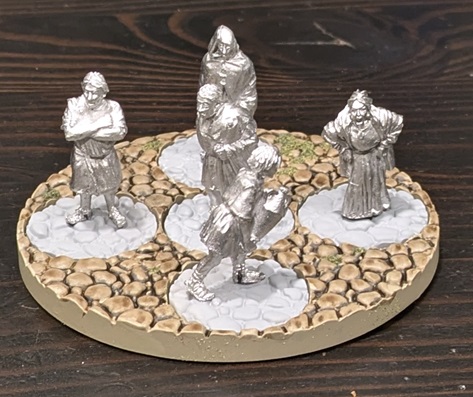
The closest thing to a catch-up mechanic is the notoriety system, but even that doesn’t have much impact, with individual gang fighters gaining notoriety from attacking mobs or Vigiles, killing enemy fighters, or ending the game controlling an objective. This requires a fair bit of tracking, with the only effect being that gang fighters with higher notoriety will be priority targets for Vigiles, and those with the highest notoriety will be unable to blend with mobs and will reduce the Disturbance Timer just by taking part in the game. This seems like a lot of effort to track for little reward, and it does very little to help a player who’s on the back foot.
Honestly, while the campaign system has a few interesting ideas, it feels poorly thought out and surprisingly underdeveloped given how many pages are dedicated to it.
Beyond the Rules
Presentation wise the book is generally solid, with rules text often accompanied by advice from Priscus, a hardened criminal who looks like he’s come straight out of a grittier version of the Cambridge Latin Course textbook. The book is helpfully split between the core rules, coming in at roughly 30 pages, advanced rules, campaign rules, and a rather lengthy appendix. The appendix includes a guide for converting fighters from the previous edition, painting guides, campaign sheets, and name and background tables. The painting guides are handy, using Army Painter and Vallejo paints, and are easy to follow for newer hobbyists. There’s also a terrain guide that provides helpful advice for assembling MDF terrain and even cutting up pieces of card to make cobblestones.
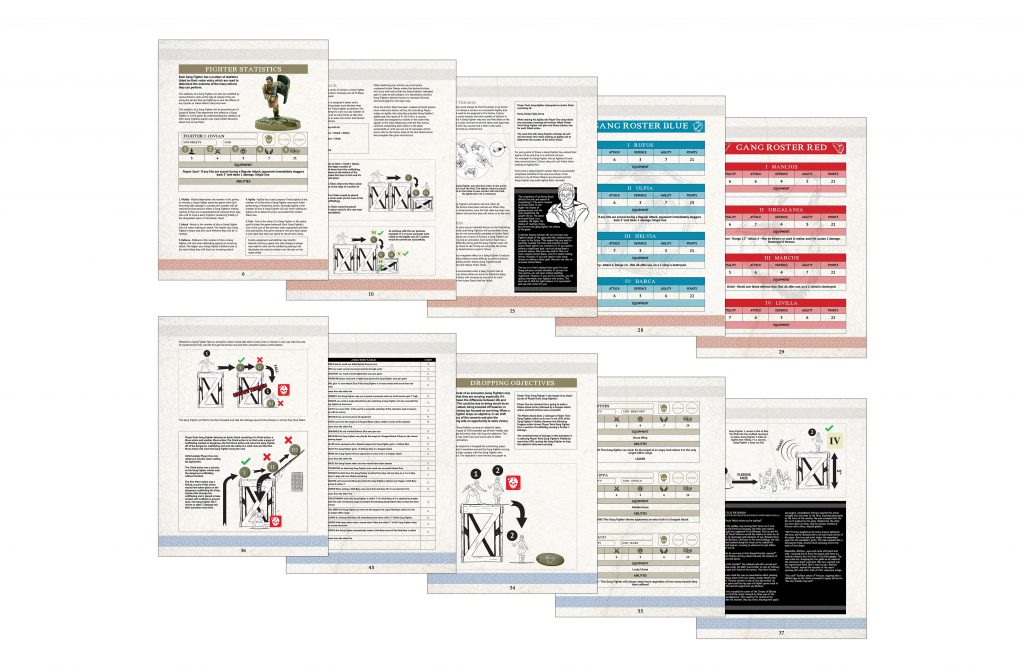
There’s an extensive set of name tables for your gang fighters, with 216 different name options for men and another 216 for women. These tables are helpful for naming your gang fighters given that most people won’t be able to come up with good latin names on the fly, but unfortunately the accompanying story tables are not nearly as good.
Part of that is down to a bizarre (and often oddly sexual) sense of humour, and some of that is down to the sheer difficulty of coming up with 216 different character traits that are all unique and interesting, each less than a sentence long. Some of that bizarre sense of humour again shows up in the special characters you can play with called Incolae, ranging from a serial killer butcher, to a pirate with a pet baboon, to a man who throws scorpions at people. However you feel about the characters themselves, their miniatures look great and their rules add just enough extra to spice up a game without being overwhelming.
A lot of these are the main characters of the short stories that appear throughout the book, which unfortunately are a mixed bag at best. The worst of these is the story about a trio of female acrobats called the Daughters of Sappho, which mixes descriptions of sexual harassment and murder. The others aren’t as bad, but mostly just serve as ways to introduce particular characters rather than give you a better feel for the setting.
For a game that features women so prominently in its art and miniatures photos, Gangs of Rome features surprisingly few female characters of any sort. Only two of the eight short stories feature any women, only two of the fifteen special characters are female, and only one of the eight Rome’s Most Wanted mercenary gangs feature any women (that one being the aforementioned all-female Daughters of Sappho). The game is also surprisingly white given how culturally diverse Rome was for much of its history, with no Black people appearing in the book at all to my eyes beyond a single reference to a Nubian in one of the short stories.
None of this affects how the game plays of course, but it does mean the book doesn’t make full use of the incredible setting they have access to. A lot of historical wargames understandably end up revolving around white men due to the simple fact of when and where they’re set, but given that this game is based around the actions of civilians in what was probably the most diverse city in the ancient world, it’s a little disappointing that its not using its setting to buck the trend quite as much as it could.
If you do want to put the focus of your games more on the diversity of Rome, or if you want to focus on another city altogether, the rules and miniatures still offer everything you’d need. Gang fighter creation is written as gender neutral and lets you easily populate your gang with whatever kind of characters you want, the women’s name tables are just as extensive as the men’s, and named characters can easily be reflavoured if you just want to use their unique mechanics.
Gangs of Rome Accessories Box Set
Footsore Miniatures also sell an accessory kit for Gangs of Rome and this is a great way to get started with the game. The kit comes with five sprues of the Wargames Atlantic Citizens of Rome models, along with enough MDF bases to get you the three five-person mobs you’ll need for most scenarios, plus two gangs of five models a side with five models still on sprue. Full-size gangs come in at around eight models, and some scenarios require up to five mobs, so while you can play a full game with the five sprues included, you may want to get an extra set of sprues to run larger games, though if you do you’ll have more than enough to play even the largest of games with enough spare models for a third gang and more.
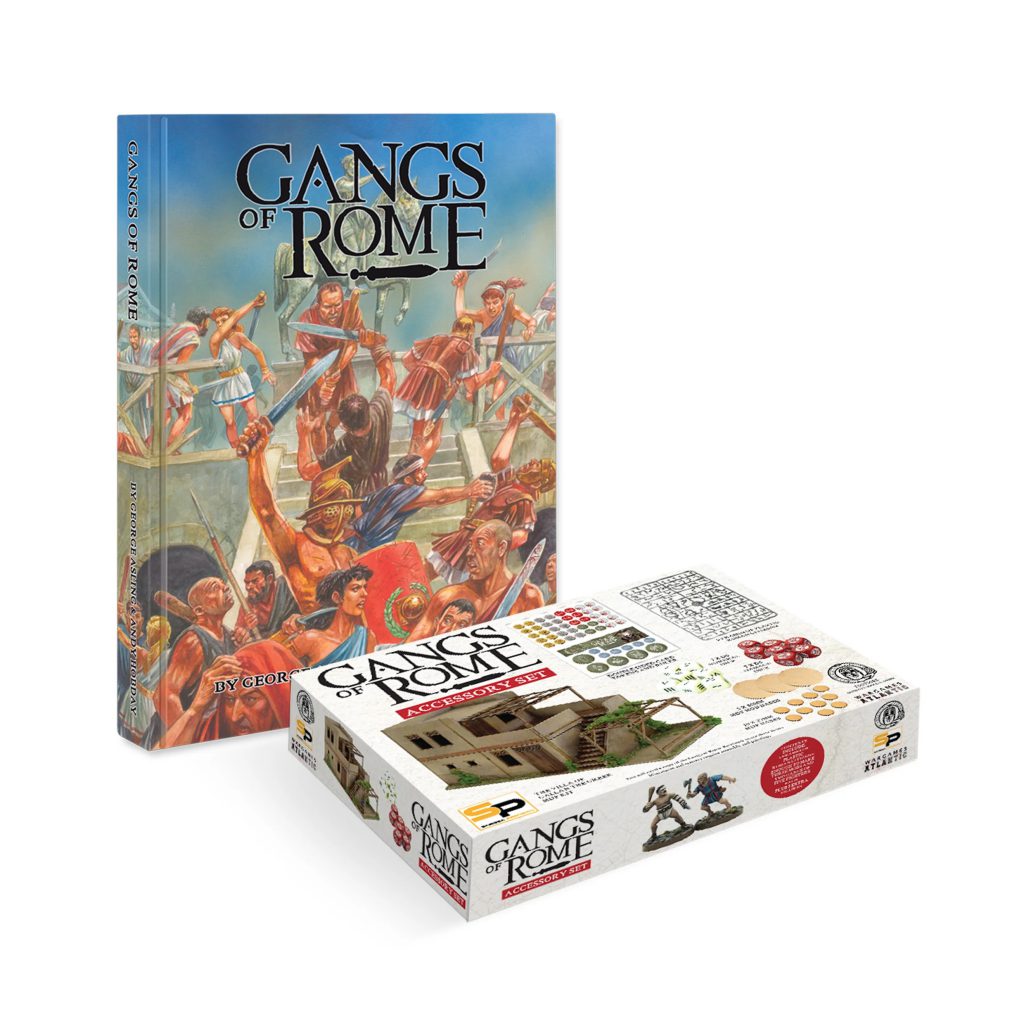
There’s an array of tokens and objective markers included in the accessory set, alongside a range ruler and some dice. You get 14 six-sided dice in total, seven of which are damage dice (numbered dice with skulls on them), and seven of which are numbered in roman numerals. While you could easily play the game with any six-sided dice you have already, there’s actually some neat design work that’s gone into including these particular dice in the accessory kit. For starters, no model has more than seven vitality, which means you’ll only ever need one damage die to track each model’s remaining vitality, and only the rarest of rolls will require more than the seven dice you get from this kit. At first the roman numeral dice seemed like they were included more for aesthetic reasons than any practical ones, and seemed likely to slow down the game if used since most people won’t recognise roman numerals as well as they do standard dice symbols. However, there’s one clever element of the game that might even make the roman numeral dice more practical than traditional ones.
You see, as mentioned earlier, Gangs of Rome revolves around skill checks where you roll multiple dice looking for 4s or higher for successes, and as the book mentions, it works out that every result of 4 or higher (IV, V, and VI) has a V in it, while every result below 4 (I, II, and III) doesn’t. As a result, all you need to do when rolling is look for the V symbol, which can actually speed up play over traditional dice once you get used to it.
The final thing included in the accessory kit is a piece of MDF terrain, the villa of ‘Gallan the Greek’. This is a great kit from Sarissa Precision who do a lot of great MDF terrain for a bunch of settings and systems, including a whole range for Gangs of Rome that looks great, and based just on the villa included here, I’m definitely going to be picking up a bunch more.

This was my first time building MDF terrain, and it was really nice and simple. The instructions were easy to understand, and while the components weren’t individually numbered they were each visually distinct enough that you could tell what they were and where they went just from the pictures. I completed it in around two hours, with only two minor difficulties. The first was the stairs, of which there were twelve steps which all needed to be glued in separately, which were a little time consuming. The other issue was that the thinness of some of the trellises meant they were quite fragile and difficult to handle safely. I managed to get them all off the frame fine, but I broke part of one while trying to loose fit the upper floor. The terrain looks phenomenal once completed, and Sarissa has a large range of terrain available for the setting, which is especially important since the game relies so heavily on it.
The accessory kit itself comes in at £60 (or on offer for £80 if bought alongside the normally £30 core rulebook) and is decent value for its cost, though not extraordinary. Alone, the miniatures would be £30, and while the MDF villa is exclusive to the accessory kit at present, similar sized MDF kits cost around £10-15. That leaves you with the bases, dice and tokens making up the final £15-20, and whether or not that’s worth it is up to the individual. However, the accessory kit also comes as part of a £80 bundle with the normally £30 core rulebook, and that bundle feels like much better value and definitely worth a purchase since it gives you everything you need to play.
Wargames Atlantic Citizens of Rome
Footsore produce a bunch of different metal miniatures for Gangs of Rome, and while I haven’t tried any of them personally, the sculpts look great and I’ve heard good things about their metal miniatures in general. However, your best bet for filling out your gang is going to be the Wargames Atlantic Citizens of Rome box that comes with the accessory kit. Each box comes with five sprues that have six models on them each, and overall it’s a great kit that’s extremely unique and perfect for Gangs of Rome.

Most of the legs and torsos will fit together nicely with any of the others, and you have various options for tunics, shirts, and togas, both with and without sleeves. While this lets you create a variety of different models that definitely look more like a mob than a uniformed force, it also means that a lot of the arms only work with certain torsos which does reduce your options a fair bit. One of the torsos has an inbuilt cloak for use with a specific left arm clutching a cloak, and any other arm leaves the model looking like it’s just wearing a cape.
There’s also one pair of legs and torso on each sprue that only work with each other, allowing you to build a model with a loincloth that looks like it would be perfect for a gladiator. Unfortunately, if you’re a gladiator nerd and care about accurately representing the historical Roman gladiator classes, you’ll be a little disappointed with this part of the sprue. The only option you can really build is the Hoplomachus (a gladiator armed with spear and shield in the style of a Greek Hoplite), since there’s no trident or net for a Retiarius, the shields are the wrong shape for a Murmillo or Samnite, and the arm with the curved sword of the Thraex is sleeved so doesn’t fit with the gladiator torso. It’s still a pretty good option for building an escaped gladiator or a rough and tumble kind of fighter with a more eclectic mix of weaponry.
If you’re not a gladiator nerd, however, or you’re more concerned with building the mix of gang fighters and civilians that Gangs of Rome is all about, this kit has everything you could want. There’s a variety of weapons available, from swords, axes, and clubs, to slings, spears, javelins, and bows. There’s two shields per sprue, both round but one smaller than the other, many of the arms are wearing arm guards, and there’s a pair of greaves on each sprue that can be worn on most of the legs. For your civilian models, there’s a large number of empty hands so you can have completely unarmed models, and there are two arms holding amphorae (Roman wine jugs) on each sprue which look great with the Romans and also make for fun kitbashing fodder.
Overall, this is a great kit, the sculpts are fantastic and seemingly fit quite well with the scale of the metal footsore miniatures. The level of detail is exactly what you want from these kinds of miniatures, and they look iconically Roman, with even the faces looking like the kind you’d find marble busts of in museums.
It’s a bit of a shame that there’s no plastic option for female Roman citizens at the moment, since any game focused around civilians is going to feel a little lacking without women, though you do have a fair number of options for female characters from Footsore’s range of metals. If Wargames Atlantic ever made a sprue of Roman women with the same quality as this kit, however, I’d absolutely be the first person in line for them.
Closing Thoughts
Gangs of Rome is a good game overall, but it’s tantalisingly close to being a great game, held back by a rulebook that feels like it didn’t have quite the care and attention put into it that it deserved. The game itself still manages to be a lot of fun despite the book’s issues, and the setting is iconic and filled with endless potential.
The biggest thing that will hold it back for most people, however, is simply the terrain requirement. It’s a terrain heavy game in a setting that only a handful of people will have any existing terrain for, and despite the excellent terrain range that Sarissa Precision offers, that’s still going to turn a lot of people away.
If you’re not all that interested in gang warfare in ancient Rome, there’s still a lot to like in this system with the interesting push-your-luck action stack rules being a highlight, but if you are interested in the concept then the game delivers everything you could ask for, supported by an excellent accompanying range of miniatures and terrain that would be worth your attention on their own.
Have any questions or feedback? Drop us a note in the comments below or email us at contact@goonhammer.com. Want articles like this linked in your inbox every Monday morning? Sign up for our newsletter. And don’t forget that you can support us on Patreon for backer rewards like early video content, Administratum access, an ad-free experience on our website and more.


